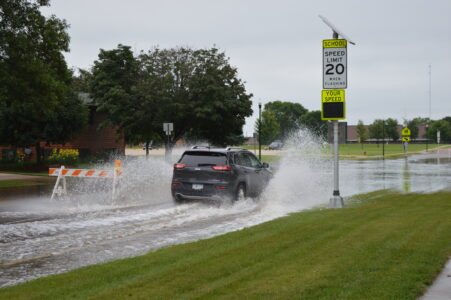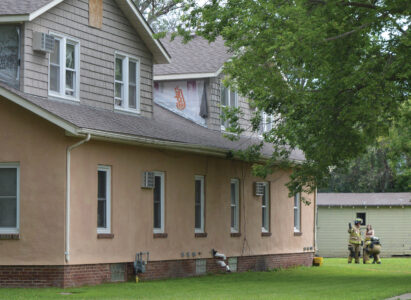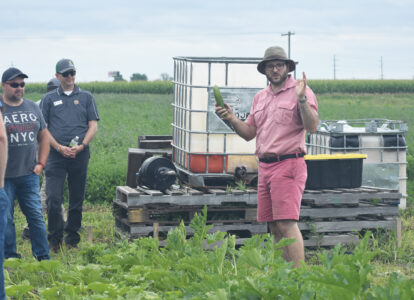Marshall lauded for ‘painting the city’ green
MARSHALL — Minnesota GreenStep Coordinator Phillipp Muessig told 30 attendees at a GreenStep community forum Thursday that Marshall’s chapter has been top-notch in the state for efforts to paint the city green.
The forum, held at the Red Baron Arena and Expo, was a prime example of “going green.”
Preston Stensrud, parks superintendent for the city of Marshall, explained how the arena cooled the facility with reclaimed cold air from the ice arena.
“The expo has been open for 1 1/2 years,” Stensrud said. “And 55 percent of the cooling is made up of recycled air. Heat is also generated from motors and engines and used as reclaimed heat.”
The electrical use is 30 percent lower than the planners had estimated, he said.
Stensrud also reported on Marshall being a “tree city,” saying grants require the city to spend $2 per capita on trees and their care.
“We’ve added over 200 new trees already this year,” Stensrud said, “and we’re adding 40-50 more this fall.”
“Marshall puts a lot of emphasis on green space,” Marshall GreenSpace Coordinator Tom Hoff said.
Hoff then introduced Jason Anderson, also representing the city of Marshall, who talked about another area that receives a lot of attention, the regional pond.
“The regional pond collects storm water to recycle and be reused,” Anderson said.
The pond is near the high school and the university. There is a pump station, he said, that helps the schools utilize the water to irrigate the ball field.
He said that 7.7 million gallons of water are reclaimed through this pond. There were 4,000,000 gallons used in July alone, saving the entities $25,650 on utilities fees.
“They have beautiful grass, too, without the cost,” Hoff said.
Anderson shared the results of the J-turn on the intersection of Saratoga and Minnesota Highway 23.
“It was probably not the most popular project right away, but people have come to understand and appreciate the safety factor,” Anderson said. “A J-turn is designed to reduce T-bone crashes and fatalities.”
The pedestrian bridge was also not a popular project, but since it was built there have been 20,596 individual crossings on it, he said.
Other green projects discussed included the Camden Regional Trail, mattress recycling, Healthy 56258 — including Farmers Market and other healthy programs, the Marshall Municipal Utilities saving over 30 percent on its electricity from renewable resources and LED lighting in 2016. Marshall Public Schools have also changed to LED lights and implemented other energy- saving programs.
Volunteers from GreenStep have inspired others to help the city by cleaning up garbage on vacant lots. The city government provides trash bags and gloves for GreenStep volunteers. Business owners got into the mix by providing dumpster space or a free meal for the volunteers.
Almost every member of the forum had a story to tell about how their business or organization contributed to keeping Marshall green, yet they all knew there were opportunities for greater efforts.
The second half of the forum was dedicated to brainstorming lists of strengths, weaknesses, opportunities and threats to GreenStep’s efforts.
Strengths included cooperation and collaboration among volunteers, the use of renewable energy, recycling water, community gardens, curbside collection of recyclables, planting trees, Farmers Market, food shelf and community champions who step up and take the lead.
Weaknesses included trash cans overflowing, lack of recycling containers at gas stations, food swamp/desert, need to increase the percentage of citizens who recycle and the need to take GreenStep to the next level and make sure it is sustainable.
Opportunities listed included water quality improvement, providing garbage and recycling containers near cart stalls in parking lots at department stores, charging a fee for plastic bags, grow your own food, establishing a Chamber leadership academy, home composting and raising awareness and participation in GreenStep.
Threats to the environment included plastic bags that blow all over, lack of structure and communication, variable levels of volunteer commitment, using too much paper (i.e. copy machines) shortage of fresh water and water quality.
After these lists were made, Muessig and Development Planner Judy Elling Przybilla of the Southwest Regional Development Commission led the small groups through a cafe discussion on how the GreenStep city effort can have a greater community impact in Marshall and Lyon County, and how can it be more integrated into the city/county and community decision making?
One of the answers was to make it a regional effort not just citywide. Another was getting the word out in a way that generated enthusiasm toward GreenStep and its projects.
Sustainability was a by-word for the day. Leaders were concerned that they had poured all this effort into a good thing, but there may not be anyone to carry the torch into the future. Appointing a sustainability coordinator seemed to be the answer to that.
Also, putting together a Youth Energy Summit, getting someone from each city department to sit on the GreenStep board and to have best practices in front of them.
Reaching out to the city council departments during critical decision making times, laying out clear steps of how to get to be The Best City in Minnesota, and making sure big businesses were at the table were other ideas generated, along with policy system environmental changes.
“What we’re trying to do here is create a climate and environment that people want to live in and enjoy,” Hoff said.
Kyle Box, representing the city of Marshall, said it was amazing to see how well everyone is taking the initiative to improve the city and county.



